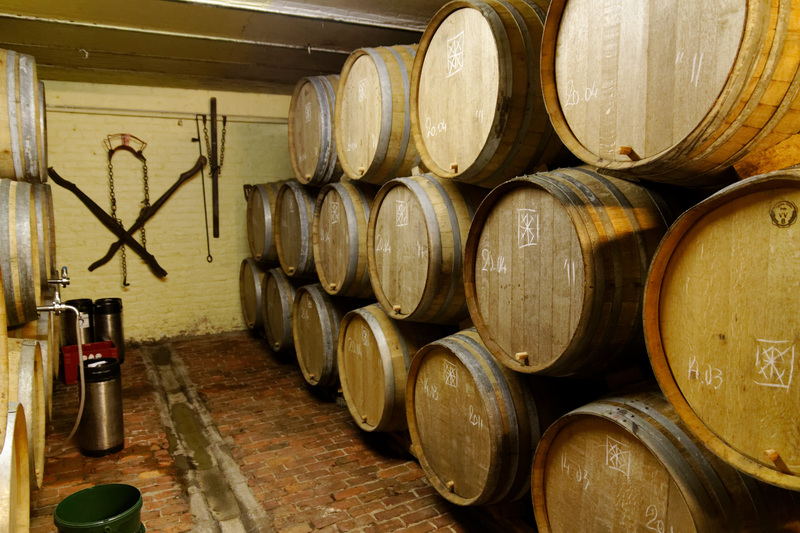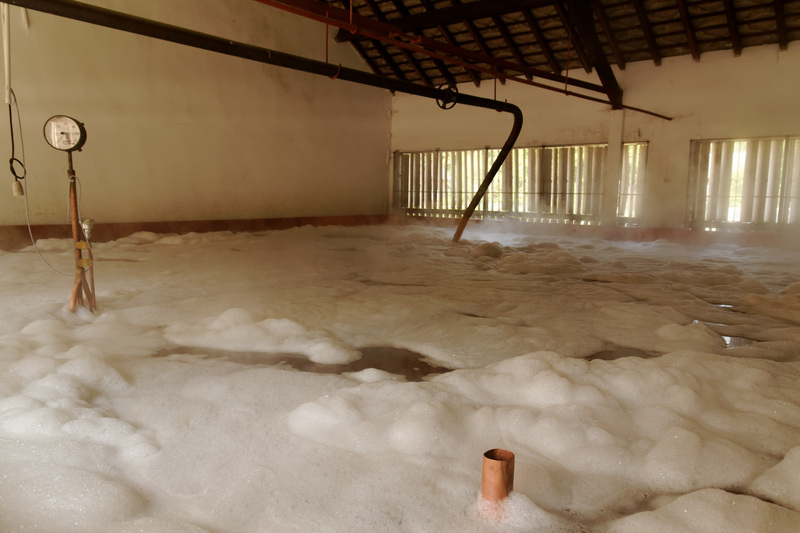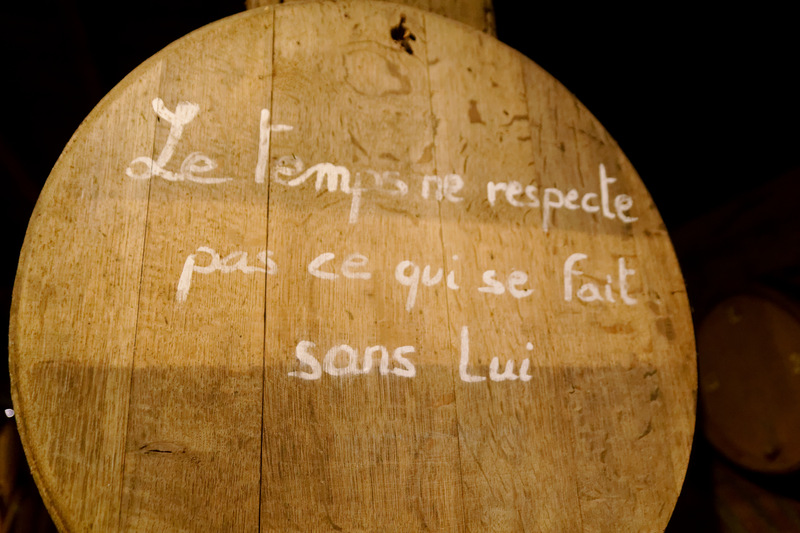What is it that ferments lambic?

Lambic casks, Cantillon, Brussels |
As everyone knows, lambic is fermented by "wild yeast and bacteria". But what does that actually mean? What yeast? And what bacteria? This is not an easy question to answer, but last year a study attempting to answer this was published. The results are interesting in several different ways, so let's take a look.
Let's consider what they're doing first. A batch of lambic is fermented in a fairly big stack of wooden casks piled on top of one another. It stays there for one to three years. The task of the researchers was to say what microorganisms are in there. This is non-trivial when a thousandth of a liter can contain 10 million microorganisms, or even more, and these are unlikely to be evenly distributed in the fermenting beer. A further challenge is that, obviously, these critters are too small to be seen, except with a microscope, and too many to be counted.
The solution was to take samples, and to hope that these samples were representative. The researchers picked two batches of lambic (from Cantillon), one started 25 February 2010 and one started 23 March 2010. Samples were taken from four casks in each batch. Samples were taken from a small sampling hole plugged with a cork, about 10cm above the bottom of the casks. The bung hole on the top couldn't be used, because the casks were piled on top of each other.

Lambic casks, Drie Fonteinen, Beersel |
Samples were taken after the wort was cooled overnight, and then at the following time intervals after transfer to cask: 15 minutes, 1, 2, and 3 weeks, 1, 2, 3, 6, 9, 12, 18, and 24 months. From each sample, tiny, tiny samples were then taken, and grown on agar gel. In order to separate yeast and bacteria, the yeasts were grown on gels with antibiotics, and the bacteria were grown on gels with poisons killing yeast.
In order to judge which bacteria/yeasts dominate the fermentation, they basically spread the samples out on the agar plates, allowing colonies to form. Then you identify the species forming each colony, and sum up the totals. This gives an idea of the total population, without being entirely accurate. (Results were double-checked using another method, indicating that these results are fairly accurate.) Since yeast and bacteria were grown separately, there's no way to judge the balance of yeast versus bacteria in the beer.
In the diagram below you can see the results for the bacteria. The reason there are two bars for each time period is because two different growth media were used.

Bacteria results, from Spitaels et al 2014 |
The picture is quite complicated, but if we simplify a bit, we can describe it like this:
- First few days: mostly Escherichia/Shigella, a good bit of two Enterobacter species.
- After some days until three weeks: mostly Klebsiella oxytoca and Hafnia paralvei.
- After a month: all Hafnia.
- From two months onwards: all Pediococcus damnosus.
So saying that lambic is fermented by bacteria is no exaggeration. In fact, that diagram leaves out a good bit of the species found, because the researchers found more using another method. They double-checked their finds by extracting DNA directly from the wort samples. The researchers even identified two new species, for which they proposed the names Acetobacter lambici and Gluconobacter cerevisiae.
The two Enterobacter species, Klebsiella oxytoca, Hafnia paralvei, and Escherichia/Shigella are all part of the family Enterobacteriaceae. They consume sugar and grow very rapidly, producing lactic acid and flavours which have been described as smoky, mouldy, and vegetal. As the pH sinks and the yeast starts producing alcohol, these bacteria die off. No doubt this is why Pediococcus damnosus eventually takes over.
So a simpler way of explaining this would be to say that for the first month Enterobacteriaceae rule, and then they are replaced by Pediococcus damnosus. This is another bacteria that eats sugar and produces lactic acid. Curiously, it also produces diacetly, but I can't recall ever tasting that in lambic.
So what about the yeasts? See below.

Yeast results, from Spitaels et al 2014 |
If you thought the bacteria results were complicated, that's nothing. The first three months of the yeast results are not that complicated. Ordinary beer yeast (Saccharomyces cerevisiae) starts out strong, then gradually fades until it's gone after about three months, probably because it's run out of sugar. Saccharomyces pastorianus, lager yeast, runs in parallel and takes over completely after three months. (So what is lager yeast doing in a lambic? Good question.)
From six months onwards the picture changes completely, as a whole zoo of different yeasts run riot, with no clear trends. And, of course, once again the diagram is not showing the full picture.
Now, having observed all this, the obvious question is: where do all these critters come from? Is lager yeast really floating around in the air in Brussels? Similarly, where does beer yeast come from in February and March? Now, the researchers figured you might want to know this, so they took samples in the brewery itself, then grew those in a similar way to the wort samples. They also took samples from the insides of the casks, before the wort was added.
From this they learned a few things. For example, the Enterobacter bacteria floated into the wort while it was being cooled. Saccharomyces pastorianus was actually found in the air of the cellar, so it very likely came from there. (What was it doing in the air? I honestly don't know.) There was no sign of Pediococcus damnosus, Saccharomyces cerevisiae, or Dekkera bruxellensis. So where did they come from?
They might have been missed in sampling the brewery environment. The casks had been used for lambic fermentation before, so they might come from previous batches. And originally the casks were wine casks, so conceivably the Saccharomyces that lives on the surface of wine grapes could be the source.

Industrial coolship, at Timmermans, Itterbeek |
Interestingly, just a few days ago the same team of researchers published a follow-up paper, where they did a similar investigation in what they call an industrial lambic brewery. The unnamed industrial brewery follows a very similar process, complete with coolship and all, but they acidify the wort to a pH of 4 by adding lactic acid. The paper claims this is common in all industrial lambic breweries.
The brewing process here was unusual, in that after two weeks the first batch showed no foam, indicating fermentation had not begun. The brewery solved this by mixing in parts of a 3-month old batch. Analysis shows that before the mix, the dominant yeast was Hansenispora uvarum, with some Pichia fermentans. The donor batch, on the other hand, consisted of Saccharomyces cerevisiae and pastorianus. After mixing in, these two grew steadily, slowly replacing the two previous yeasts, but never taking over entirely. Then, three months after mixing, the Saccharomyces was gone, replaced by Dekkera bruxellensis.
On the bacterial side the Enterobacteriaceae don't show up, probably because of the wort was too acidic for them right from the start. Here, too, Pediococcus damnosus takes over after about two months, but it's not alone. The two novel species found in the previous paper show up in strength here: Acetobacter lambici and Gluconobacter cerevisiae. In addition, two other Acetobacter and one Gluconobacter species shows up.
What's really curious is that Saccharomyces pastorianus (lager yeast) shows up here, too. Neither it nor Saccharomyces cerevisiae were found in the brewery environment in this case, nor in the casks, so where they came from is not clear.
To summarize, it's no surprise that lambic is complex in flavour given the ragbag army of microorganisms that go on the rampage in the fermenting wort. If you'd never tasted the beer and just looked at the analysis you might suspect the beer of being undrinkable. What's perhaps most remarkable is the degree of control these brewers must have, and the consistency they produce. One cannot help being impressed that they can do this without any direct microbiological control over what is going on. And, of course, the results are equally impressive.

Time does not respect what is done without him. Cantillon, Brussels |
Sources
The above information was mostly taken from the paper The Microbial Diversity of Traditional Spontaneously Fermented Lambic Beer, Spitaels et al, PlosONE, April 18, 2014, DOI: 10.1371/journal.pone.0095384.
In addition, I made use of the follow-up paper The microbial diversity of an industrially produced lambic beer shares members of a traditionally produced one and reveals a core microbiota for lambic beer fermentation, Spitaels et al, Food Microbiology, Volume 49, August 2015, Pages 23-32. Many thanks to Freek Spitaels for sending me a copy.
Similar posts
Yeast terminology, part 2: bacteria
We continue the series on the family tree of yeast with a post on bacteria
Read | 2015-09-05 15:28
The Saccharomyces family
The series on yeast taxonomy now ends with a post on the various species in the Saccharomyces family
Read | 2015-10-17 12:19
Comments
steve lamond - 2015-02-20 10:22:07
Fantastic summary, got the paper printing now. Really must get back to reading out more about sour/wild beers; so much science
Mike - 2015-02-20 10:48:36
It's like the person that made those charts had never heard of colour blindness.
Awesome article by the way. I would love to get a hold of the lager yeast that is just floating around in Cantillon's cellar. I love the idea of brewing a wild lager.
Ingo - 2015-02-21 06:57:41
1. Bokulich NA, Bamforth CW, Mills DA. Brewhouse-Resident Microbiota Are Responsible for Multi-Stage Fermentation of American Coolship Ale. Du C, editor. PLoS ONE [Internet]. 2012 Apr 18 [cited 2014 Dec 26];7(4):e35507. Available from: http://dx.plos.org/10.1371/journal.pone.0035507
2. Bokulich NA, Ohta M, Richardson PM, Mills DA. Monitoring Seasonal Changes in Winery-Resident Microbiota. PLoS ONE [Internet]. 2013 Jun 19 [cited 2014 Oct 24];8(6):e66437. Available from: http://dx.doi.org/10.1371/journal.pone.0066437
richard - 2015-02-24 12:08:32
woah.
Dan ABA - 2015-02-24 15:18:21
From what I have read, Saccharomyces pastorianus is not supposed to be airborne. Is my understanding correct, and is this what you meant by "What was it doing in the air? I honestly don't know."?
Thanks, great article!
Damian - 2015-02-24 19:25:36
In regards to Pediococcus producing diacetyl, but not being detected in lambics, it's that as a result of Brett and other hungry microbes consuming the diacetyl. Isn't that why Brett and Pedio work so well together? Happy for more clarification. Great read by the way.
Lars Marius - 2015-02-25 03:08:28
@Dan: I'm not an expert on this, so I don't really know for certain. I've read several places that Saccharomyces pastorianus is supposedly dependent on humans to survive, and that it doesn't exist in the wild. I tried finding those articles again while working on this blog post, but didn't succeed. Anyway, these two papers seem to show that it's not the case. (And, yes, this is absolutely what I meant.)
@Damian: I assume the reason diacetyl isn't detectable in lambics is because something else consumes it, but I don't know which of the many species of bacteria and yeast it is. Or if it's because under these specific circumstances Pediococcus does not produce diacetyl (it appears very late in the fermentation).
The researchers found only weak indications of the presence of Brett in this fermentation, so it doesn't seem likely that Brett consumed the diacetyl.
I hope this clarifies.
Patrick Beer - 2015-03-03 09:39:58
I was asked very recently while working in my shop what a Lambic was. I gave them what I thought was reasonable explanation but I can see I left out quite a bit of informaiton based on what I've read here!
What amazes me is how processes such as this are discoverd in the first place. Does someone create an experiment or do these things just happen by accident at some point in the past?
Dan ABA - 2015-03-15 01:24:33
Lars,
Have you herd of the Milk The Funk group on Facebook? It's a group focused on wild/sour beer fermentations. We've got a lot of biologists/scientists, pro brewers, and homebrewers, but we are short on historians. :) We'd love to have you come join in on our discussions if you are interested.
Cheers, Dan
Lars Marius - 2015-03-15 06:31:23
@Dan: Never heard of the group, but it sounds interesting. I'm not a historian, but I guess that's not a requirement. :)
Lars Marius - 2015-03-17 09:22:13
Freek Spitaels, the lead author of the paper, wrote to me privately, saying he doesn't think the lager yeast comes from the environment. He thinks it's probably coming from the wood of the casks, and perhaps from the wood in the brewery.
He also says there actually was Brett in the fermentation, but in the part of its life cycle where it reproduces sexually, so he used the name Dekkera bruxellensis for it (as is customary), but it's actually the same yeast as Brettanomyces bruxellensis. So I got that bit wrong.
Frank Boon - 2015-06-09 03:45:18
When were these samples of Lambic taken ? One has the profile of a Lambic brewed out of the brewing season, overgrown by Enterro bacteria.
Lars Marius - 2015-06-09 10:01:02
@Frank: The samples were taken at Cantillon. They did a follow-up analysis (in another paper) at an unnamed industrial lambic brewery. The yeast and bacteria flora there was much simpler, and did not include any Enterobacteriae.
Kjetil - 2015-10-20 05:20:27
In Wild Brews by Jeff Sparrow it says that the brett consumes the diacetyl created by the pediococcus, as it does with so many other esters created by other yeast/ bacteria. This article is by far a very good short summary of that book